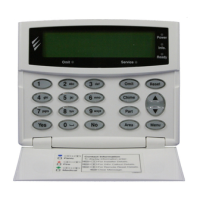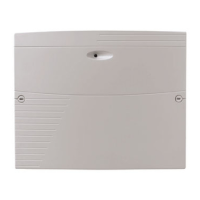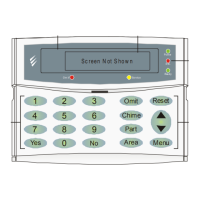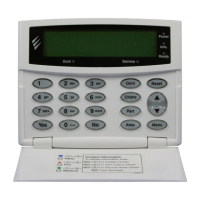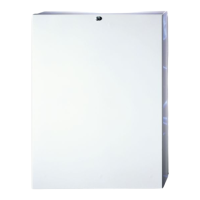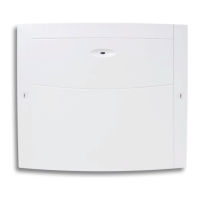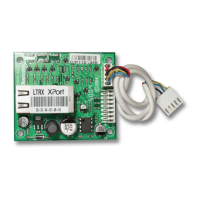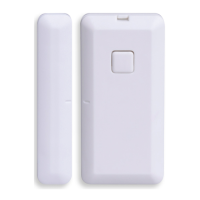Premier 48, 88, 168 & 640 Installation Manual Programming the Control Panel
INS176 75
The following options are used when a Paknet Radio-Pad is
connected to the control panel in order to achieve DUAL
SIGNALLING to an Alarm Receiving Centre, when a MODEM
(External PC or Com2400) is used to connect to the control
panel or send SMS messages to mobile phones, when an AV
Module is connected to the control panel in order to achieve
AUDIO VERIFICATION to an Alarm Receiving Centre or when
a TCP/IP Module is connected for communications over a
Broadband/ADSL/DSL Line.
Setup Radio-Pad
Pad ARC 1 Pri No
This is the first number that is used by the Radio-Pad for
reporting events to ARC 1.
Pad ARC 1 Sec No
This is the second number that is used by the Radio-Pad for
reporting events to ARC 1.
Pad ARC 1 Prefix
This number will prefix the account number for ARC 1.
Pad ARC 2 Pri No
This is the first number that is used by the Radio-Pad for
reporting events to ARC 2.
Pad ARC 2 Sec No
This is the second number that is used by the Radio-Pad for
reporting events to ARC 2.
Pad ARC 2 Prefix
This number will prefix the account number for ARC 2.
Pad ARC 3 Pri No
This is the first number that is used by the Radio-Pad for
reporting events to ARC 3.
Pad ARC 3 Sec No
This is the second number that is used by the Radio-Pad for
reporting events to ARC 3.
Pad ARC 3 Prefix
This number will prefix the account number for ARC 3.
Radio-Pad Attempts
This is the number of times the Radio-Pad will try to dial the
Alarm Receiving Centre telephone number before giving up.
The number of dialling attempts is limited to 9. If this
value is set to 0, the Radio-Pad will never dial out.
Setup AV Module
AV No. 1>
This is the first number that is dialled by the AV Module.
AV No. 3>
This is the second number that is dialled by the AV Module.
AV No. 3>
This is the third number that is dialled by the AV Module.
AV Dial Attempts
This is how many times the AV Module will attempt to dial
before giving up.
The number of dialling attempts is limited to 9. If this
value is set to 0, the AV Module will never dial out.
AV Re-Dial Delay
This is the amount of delay that the AV Module uses between
re-dialling telephone numbers.
Setup IP Module
ComIP Address
This is the IP Address of the IP Module.
ComIP Port
This is the Port number of the IP Module.
ComIP Gateway
This is the Gateway IP Address that the IP Module
communicates through.
ComIP Mask
This is the Subnet Mask number for the IP Module.
Polling/SMG Address
This is the IP address of a dedicated Polling or SMG Server
that the IP Module might need to connect to.
Name/SMG Port
This is a descriptive name for the IP Module or SMG Port and
might be used for authentication purposes.
SMS Centre Pri.
This is the first SMS centre telephone number that is used by
for sending SMS to mobile phones. (Default = 07860
980480).
SMS Centre Sec.
This is the second SMS centre telephone number that is used
by for sending SMS to mobile phones.
Modem Setup Stg.
If a standard PC modem is connected to Com1 or Com2, it
may require a configuration string to make it work properly
(please refer to instruction manual of modem being used for
details of required AT commands).
The Setup string is programmed the same way that
TEXT would be programmed and has a maximum
length of 16 characters.
The setup string does NOT require AT to be entered at
the beginning as this is done automatically.
Modem Speed
This option allows the speed of a standard PC modem
connected to Com1 or Com2 to be adjusted.
Pad Serial No.
This screen displays the Serial number of the Radio-Pad that
is connected.
Pad NUA
This screen displays the NUA number of the Radio-Pad that is
connected.
Last Call From
This screen displays the NUA number of the last Radio-Pad
that communicated with the Radio-Pad that is connected to
the control panel.
FSS:??? (>=004), Forward Signal Strength
RSS:??? (>=050), Reverse Signal Strength
This screen displays the Radio-Pad Forward (FSS) and
Reverse (RSS) Signal Strength of the Radio-Pad that is
connected to the control panel.
The FSS value should be greater than or equal to 4 and
the RSS value should be greater than or equal to 50.

